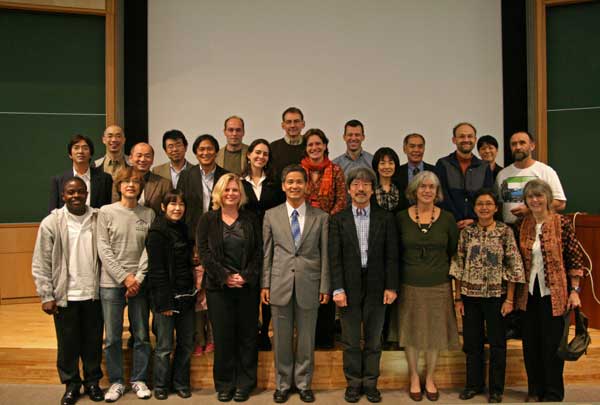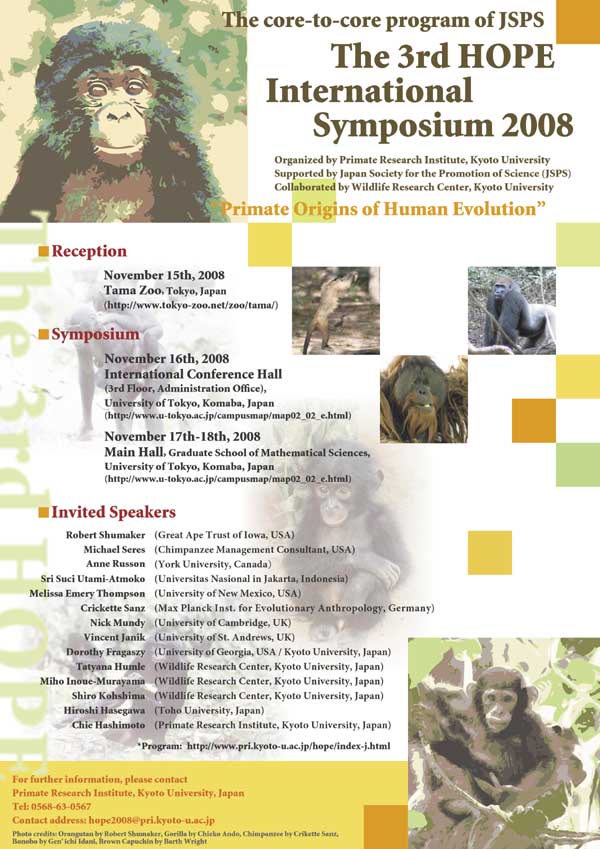| Japanese |
HOPE Project
Primate Origins of Human Evolution |
|
| The core to core program of JSPS |
| The 3rd HOPE International Symposium 2008 |
| "Primate Origins of Human Evolution" |
Organized by Primate Research Institute, Kyoto
University
Supported by Japan Society for the Promotion of Science (JSPS)
Collaborated by Wildlife Research Center, Kyoto University
The symposium was successfully held in Tama Zoo and
University of Tokyo in November 15-18, 2008. Thanks are due to the
collaboration among the participants from various fields.
The symposium was financially supported by Japan Society for the
Promotion of Science (JSPS).
 |
Program
| November 16th |
International Conference Hall, University of Tokyo,
Komaba, Japan |
| 15:30 - 16:20 |
Robert Shumaker (Great Ape Trust of Iowa, USA) |
| Title |
The orangutan program at great ape trust of Iowa:
working to better understand, preserve, and protect the red ape. |
| Abstract |
 The mission of Great Ape Trust of Iowa is composed of four distinct parts. We study the behavior and intelligence of great apes, actively promote in situ conservation of great apes, advocate for the welfare of great apes in captivity, and provide unique educational experiences to a wide variety of audiences. Each of these areas is well represented within the orangutan (Pongo spp.) program at the Trust, and specific examples will be discussed. An additional
goal of this program involves integration of data collected from the wild
and from captivity in order to promote a more complete understanding of
orangutans. Study of the reproductive life history traits of female orangutans
is one area of active collaboration. An overview of data collected from
the wild and from captivity will be presented that illustrates the variability
that exists for female orangutans. Finally, an integrated perspective on
orangutans will be discussed in the context of promoting individual welfare
and enlightened care in captivity. The mission of Great Ape Trust of Iowa is composed of four distinct parts. We study the behavior and intelligence of great apes, actively promote in situ conservation of great apes, advocate for the welfare of great apes in captivity, and provide unique educational experiences to a wide variety of audiences. Each of these areas is well represented within the orangutan (Pongo spp.) program at the Trust, and specific examples will be discussed. An additional
goal of this program involves integration of data collected from the wild
and from captivity in order to promote a more complete understanding of
orangutans. Study of the reproductive life history traits of female orangutans
is one area of active collaboration. An overview of data collected from
the wild and from captivity will be presented that illustrates the variability
that exists for female orangutans. Finally, an integrated perspective on
orangutans will be discussed in the context of promoting individual welfare
and enlightened care in captivity. |
| 16:20 - 17:00 |
Michael Seres (Chimpanzee Management Consultant, USA) |
| Title |
Chimpanzee (Pan troglodytes) introductions and group formations in
captibity:
unique individuals, damaged minds - all learning to get along. |
| Abstract |
 This presentation serves as a guide to introduce individual Chimpanzees successfully. It can also be used as a blueprint on how to construct a multi-male, multi-female social group from scratch, and how to integrate an individual of any age and gender into an already established captive social group of any size. This presentation serves as a guide to introduce individual Chimpanzees successfully. It can also be used as a blueprint on how to construct a multi-male, multi-female social group from scratch, and how to integrate an individual of any age and gender into an already established captive social group of any size.
Chimpanzee introductions, separations and restorations, integrations and group formations involving a number of individuals from various origins and backgrounds are the everyday task of various institutes across the globe. Unifying methods, and following proven steps of introductory techniques that help the well-being of many socially inept, often mentally disturbed individual Chimpanzees is essential.
Interaction between unrelated individuals within a Chimpanzee group is
crucial. In order to be accepted successfully, an individual needs to interact
and maintain relationships effectively with group members. Besides many
considered “normal” or adequately skilled social individuals, there are
a huge number of ex-pets, and ex-laboratory Chimpanzees that show gross
behavioral abnormalities (Brüne et al., 2006). The author has conducted
a series of carefully crafted and observed, well recognized introduction
procedures, originating in literally thousands of introduction trials in
the past number of years.
Forming social groups, introducing individuals to one another and into established groups is not simple, especially since an ape [Chimpanzee] that was isolated from its conspecifics and raised by humans cannot be a real ape. (Matsuzawa 2006)
To grant free will to individual Chimpanzees exposed to one another and enable them to make decisions as to whether they want to interact or not, is the key part of dyadic introductions, that then leads to group formation. The main goal is to recognize individual Chimpanzee’s intentions by reading the individuals’ verbal and nonverbal cues while interacting, and then, when they are ready, allow individuals together in order to build a well functioning social group. We Humans are responsible for creating and managing groups of Chimpanzees that get along relatively well. We Humans are responsible for the well-being of Chimpanzees in captivity, we owe our closest relatives a great deal of attention and understanding. It is our moral obligation to provide the best life possible for our cousins, as long as we keep them locked up.
“Chimps 'R' Us!!” It is time to recognize the need; it is time to do the right thing! The aim of this presentation is to convince the audience that it can be done. |
| November 17th |
Main Hall, Graduate School of Mathematical Sciences, University of Tokyo,
Komaba, Japan |
| 9:00 - 9:10 |
Opening Remarks Tetsuro Matsuzawa (Primate Research Institute, Kyoto University,
Japan) |
| 9:10 - 10:00 |
Melissa Emery Thompson (University of New Mexico, USA) |
| Title |
What hormones tell us about behavior in female chimpanzees. |
| Abstract |
 Studies of hormone physiology can not only describe general patterns of
primate biology, but can valuably reinforce and inform our behavioral observations.
With this goal in mind, the Kibale Chimpanzee Project has conducted ongoing
urine collection for over 10 years with the wild Kanyawara chimpanzees
at Kibale National Park. Here, I review some of our findings about the
reproductive and stress physiology of female chimpanzees, and how these
studies have illuminated previously unexplained aspects of female behavior.
Variation in food resource access among individuals and over time produces
demonstrable effects on female reproductive function. Variation in fecundity,
in turn, impacts relationships with males by influencing attractiveness,
coercion, and the intensity of male-male competition. The importance of
resource access also elicits costly female competition over prime foraging
areas. Over the life course, the dynamics of these relationships change
and interact in complex ways with age-related changes in physiology. Studies of hormone physiology can not only describe general patterns of
primate biology, but can valuably reinforce and inform our behavioral observations.
With this goal in mind, the Kibale Chimpanzee Project has conducted ongoing
urine collection for over 10 years with the wild Kanyawara chimpanzees
at Kibale National Park. Here, I review some of our findings about the
reproductive and stress physiology of female chimpanzees, and how these
studies have illuminated previously unexplained aspects of female behavior.
Variation in food resource access among individuals and over time produces
demonstrable effects on female reproductive function. Variation in fecundity,
in turn, impacts relationships with males by influencing attractiveness,
coercion, and the intensity of male-male competition. The importance of
resource access also elicits costly female competition over prime foraging
areas. Over the life course, the dynamics of these relationships change
and interact in complex ways with age-related changes in physiology. |
| 10:00 - 10:45 |
Chie Hashimoto (Primate Research Institute, Kyoto University, Japan) |
| Title |
Sex differences in ranging patterns of chimpanzees in the Kalinzu Forest,
Uganda |
| Abstract |
 While males seek to maximize access to potential mates, females maximize
feeding efficiency. Ranging patterns of chimpanzees are therefore often
sex specific. Wrangham (1979) proposed three models of chimpanzee social
systems. The “male-only community model” suggests an even distribution
of females, with overlapping core areas, independent of the male’s range.
Second, the “male-bonded community model” hypothesized that females settle
within the range defended by males but use individually distinct home ranges
to minimize feeding competition. Third, the “bisexually bonded community
model” suggests that males and females use the entire community range
equally. Previous studies revealed that social organization in eastern
chimpanzees is best described by a male-bonded community model (Williams
et al., 2002), while in western chimpanzees it is best described by a bisexually-bonded
model (Lehmann and Boesch, 2005). This study examined ranging patterns
of male and female chimpanzees in the Kalinzu Forest. In Kalinzu, home
range of both males and females showed a similar pattern, although home
range of males is a little larger than that of females. Core areas of males
were also very similar with those of females. Despite similarity of home
ranges and core areas between males and females, percentage of the attendance
at mixed parties was different between them. Sex differences in social
organization are discussed for chimpanzees in the Kalinzu Forest. While males seek to maximize access to potential mates, females maximize
feeding efficiency. Ranging patterns of chimpanzees are therefore often
sex specific. Wrangham (1979) proposed three models of chimpanzee social
systems. The “male-only community model” suggests an even distribution
of females, with overlapping core areas, independent of the male’s range.
Second, the “male-bonded community model” hypothesized that females settle
within the range defended by males but use individually distinct home ranges
to minimize feeding competition. Third, the “bisexually bonded community
model” suggests that males and females use the entire community range
equally. Previous studies revealed that social organization in eastern
chimpanzees is best described by a male-bonded community model (Williams
et al., 2002), while in western chimpanzees it is best described by a bisexually-bonded
model (Lehmann and Boesch, 2005). This study examined ranging patterns
of male and female chimpanzees in the Kalinzu Forest. In Kalinzu, home
range of both males and females showed a similar pattern, although home
range of males is a little larger than that of females. Core areas of males
were also very similar with those of females. Despite similarity of home
ranges and core areas between males and females, percentage of the attendance
at mixed parties was different between them. Sex differences in social
organization are discussed for chimpanzees in the Kalinzu Forest.
|
| 10:45 - 11:40 |
Tatyana Humle (Wildlife Research Center, Kyoto University, Japan) |
| Title |
The ant and the chimpanzee: a fable on the origins of culture in humans. |
| Abstract |
 Ant-dipping is a tool-use behavior that has been observed across several
wild chimpanzee communities across Africa. This tool-use behavior, which
involves the use of a modified stick or stalk of vegetation to gather biting
and gregarious army ants (Dorylus spp.), is often cited as one of the best
examples of culture in chimpanzees. Army ant consumption presents both
intra- and inter-community variations as to where it is present and performed,
what species of army ant is targeted, and how it is performed. It thus
provides a unique opportunity to investigate the respective influences
of ecology, development and social parameters on individual and community-wide
variations in behavior. Recent data from Bossou in southeastern Guinea
and detailed entomological analysis of the army ant species available at
different chimpanzee study sites, as well as direct observations of this
behavior, indicate that the aggressiveness and the density of the ant species
influence tool length and the technique employed to consume the ants off
the tool. Behavioral differences persist, however, between the communities
of Taï, Côte d’Ivoire, and Bossou, where the same species of
driver ants are consumed by the chimpanzees. A comparative study between
these two long-term field sites indicates that these differences reflect
conformism or conservatism within communities rather than ecological differences.
A longitudinal study of the acquisition of ant-dipping among the chimpanzees
of Bossou also reveals the importance of the role of the mother and opportunity
to observe and practice the behavior in the learning process of young chimpanzees.
Finally, a comparative approach between study sites of chimpanzees, combined
with a detailed analysis of the acquisition of this behavior, demonstrate
a narrow relationship between ecology, social learning and culture. Ant-dipping is a tool-use behavior that has been observed across several
wild chimpanzee communities across Africa. This tool-use behavior, which
involves the use of a modified stick or stalk of vegetation to gather biting
and gregarious army ants (Dorylus spp.), is often cited as one of the best
examples of culture in chimpanzees. Army ant consumption presents both
intra- and inter-community variations as to where it is present and performed,
what species of army ant is targeted, and how it is performed. It thus
provides a unique opportunity to investigate the respective influences
of ecology, development and social parameters on individual and community-wide
variations in behavior. Recent data from Bossou in southeastern Guinea
and detailed entomological analysis of the army ant species available at
different chimpanzee study sites, as well as direct observations of this
behavior, indicate that the aggressiveness and the density of the ant species
influence tool length and the technique employed to consume the ants off
the tool. Behavioral differences persist, however, between the communities
of Taï, Côte d’Ivoire, and Bossou, where the same species of
driver ants are consumed by the chimpanzees. A comparative study between
these two long-term field sites indicates that these differences reflect
conformism or conservatism within communities rather than ecological differences.
A longitudinal study of the acquisition of ant-dipping among the chimpanzees
of Bossou also reveals the importance of the role of the mother and opportunity
to observe and practice the behavior in the learning process of young chimpanzees.
Finally, a comparative approach between study sites of chimpanzees, combined
with a detailed analysis of the acquisition of this behavior, demonstrate
a narrow relationship between ecology, social learning and culture. |
| 11:40 - 12:35 |
Crickette Sanz (Max Planck Inst. for Evolutionary Anthropology, Germany) |
| Title |
Chimpanzee tool traditions in the Ndoki Forests of northern Republic of Congo. |
| Abstract |
 Humans show extraordinary talent in using objects to achieve their goals and change the environment. Although tool use has been observed in various taxonomic groups, flexible tool use seems limited to the great apes and chimpanzees in particular have often served as referential models of early hominid technology. Long-term studies of wild chimpanzees have revealed intriguing differences in the tool using behavior observed among populations, which are not directly attributable to genetic or ecological factors. However, little information has been contributed from direct observations of the Lower Guinean subspecies of chimpanzee (Pan troglodytes troglodytes) residing in the Congo Basin. We attempt to rectify this situation by presenting our ongoing observations of the technological system of chimpanzees in the Goualougo Triangle located in northern Republic of Congo. Since 1999, we have been documenting the tool use of chimpanzees by direct observations, remote video monitoring, and collections of tool assemblages. The chimpanzees of the Goualougo Triangle have a relatively large tool repertoire, which includes more than twenty different types of tool using behaviors. Several of these behaviors have been defined in other chimpanzee populations, but we also provide detailed observations of less known behaviors such as honey pounding, leafy rain covers, and ant nest perforation. The frequent use of tool sets (more than one tool with different functions used in serial order) is another compelling feature of the technological system of these chimpanzees. We have repeatedly documented the use of tool sets in honey gathering, termite and ant predation. The diversity and complexity of the tool technology of these central African chimpanzees has important implications for better understanding ape traditions and evolutionary models of tool using behavior. Humans show extraordinary talent in using objects to achieve their goals and change the environment. Although tool use has been observed in various taxonomic groups, flexible tool use seems limited to the great apes and chimpanzees in particular have often served as referential models of early hominid technology. Long-term studies of wild chimpanzees have revealed intriguing differences in the tool using behavior observed among populations, which are not directly attributable to genetic or ecological factors. However, little information has been contributed from direct observations of the Lower Guinean subspecies of chimpanzee (Pan troglodytes troglodytes) residing in the Congo Basin. We attempt to rectify this situation by presenting our ongoing observations of the technological system of chimpanzees in the Goualougo Triangle located in northern Republic of Congo. Since 1999, we have been documenting the tool use of chimpanzees by direct observations, remote video monitoring, and collections of tool assemblages. The chimpanzees of the Goualougo Triangle have a relatively large tool repertoire, which includes more than twenty different types of tool using behaviors. Several of these behaviors have been defined in other chimpanzee populations, but we also provide detailed observations of less known behaviors such as honey pounding, leafy rain covers, and ant nest perforation. The frequent use of tool sets (more than one tool with different functions used in serial order) is another compelling feature of the technological system of these chimpanzees. We have repeatedly documented the use of tool sets in honey gathering, termite and ant predation. The diversity and complexity of the tool technology of these central African chimpanzees has important implications for better understanding ape traditions and evolutionary models of tool using behavior. |
| 12:35 - 13:35 |
Lunch Time |
| 13:35 - 14:30 |
Dorothy Fragaszy (University of Georgia, USA / Kyoto University, Japan) |
| Title |
The complete capuchin: tool use in wild monkeys in the New World. |
| Abstract |
 Wild capuchin monkeys (Cebus) use a variety of objects as tools for a variety of purposes. Capuchins are very widely distributed from northern Central America through northern Argentina, and on both sides of the Andes Mountains. The most numerous reports of tool use in wild capuchins come from monkeys in the species
C. libidinosus, the bearded capuchin, which inhabits Cerrado (dry woodland) and Caatinga (semi-arid woodland), as well as mangrove forests along the northern coast of Brazil. Groups of other
Cebus species living in dry habitats (e.g., C. xanthosternos, the
buffy-headed capuchin) also use stones as pounding tools. Capuchins use stone or wood hammers on anvils to crack encased foods (seeds, palm nuts and invertebrate prey, such as crabs) and to soften or render innocuous irritating plant materials (e.g., spiny fruits and cactus). They use stones to scrape soil and to aid in excavating tubers and roots. They use sticks as probes to get at small objects deep inside crevices. The monkeys also incorporate objects into defensive displays, pushing rocks off cliffs and slapping or tossing sticks or vegetation at snakes or other potential predators on the ground, and in courtship, by tossing stones at the favored target. Wild capuchin monkeys (Cebus) use a variety of objects as tools for a variety of purposes. Capuchins are very widely distributed from northern Central America through northern Argentina, and on both sides of the Andes Mountains. The most numerous reports of tool use in wild capuchins come from monkeys in the species
C. libidinosus, the bearded capuchin, which inhabits Cerrado (dry woodland) and Caatinga (semi-arid woodland), as well as mangrove forests along the northern coast of Brazil. Groups of other
Cebus species living in dry habitats (e.g., C. xanthosternos, the
buffy-headed capuchin) also use stones as pounding tools. Capuchins use stone or wood hammers on anvils to crack encased foods (seeds, palm nuts and invertebrate prey, such as crabs) and to soften or render innocuous irritating plant materials (e.g., spiny fruits and cactus). They use stones to scrape soil and to aid in excavating tubers and roots. They use sticks as probes to get at small objects deep inside crevices. The monkeys also incorporate objects into defensive displays, pushing rocks off cliffs and slapping or tossing sticks or vegetation at snakes or other potential predators on the ground, and in courtship, by tossing stones at the favored target.
Our research group “EthoCebus”, comprised of scientists from Italy, the United States and Brazil, developed methods of identifying sites of stone hammer use on the basis of durable physical artifacts (hammer stones, anvils, and shell remains). Using this method, together with interviews with local residents followed by inspection of potential anvil sites, we and others are developing a geographically wider picture of where capuchins use hammer tools. Researchers are now fanning out across Brazil, particularly in drier, open woodland habitats, looking for evidence of hammer tool use by capuchin monkeys. It seems at this time that using hammers to crack encased or tough foods is extremely geographically widespread among the capuchin monkeys. I will present some ideas about why tool use, and particularly hammer tool use, is more common among capuchins living in open habitats than elsewhere.
After surveying the geographic and behavioral diversity of tool use in wild capuchins, I will describe the natural history of percussive tool use in one population of bearded capuchins, together with properties of the hammer stones, anvils, and nuts commonly cracked with hammers by this population, as known from four years of work at the EthoCebus field site in
Piuai, Brazil. I will also describe how the monkeys select nuts, stones and anvils, and how they transport nuts and stones during experiments at our field site.
Work at the EthoCebus field site has been supported by grants from the Leakey Foundation and the National Geographic Society to D.
Fragaszy, from the National Science Foundation-USA to D. Fragaszy and to B. Wright, from the
CNR, EU, and Ethoikos to E. Visalberghi, and from FAPESP and CNPq to P. Izar and to E.
Ottoni.
|
| 14:30 - 15:15 |
Hiroshi Hasegawa (Toho University, Japan) |
| Title |
Conservation of the short-tailed albatross through the managements of nesting
habitats on Torishima, Japan. |
| Abstract |
 Today, most of the species of albatrosses in the world (18 out of 22 species)
are threatened with extinction largely because of interactions with fisheries.
It is recognized that, as a family, albatrosses are one of the most highly
endangered groups of birds. The Short-tailed albatross Phoebastria albatrus
was once believed to be extinct due to over-harvesting for feathers, but a
tiny population was rediscovered on Torishima (Bird Island) in Japan, a
small volcanic island in the western North Pacific. For more than 30 years
since 1976, I have been monitoring the population status of this endangered
albatross at the breeding grounds and have actively engaged in the conservation managements
to save the species. Although natural disasters, such as typhoon, winter
storm, landslide and subsequent mudflows at the nesting colony, reduced
the breeding success to less than 50% in 7- to 9-year intervals, we were
able to improve it and maintain at the level of 60 to70% through the managements
of nesting habitats, like erosion control and grass transplant. Further
we succeeded in establishing a new colony at the "safe" site,
free of landslide or mudflows, on the other side of Torishima in the 2004-05
breeding season with use of decoys and sound playback. This new colony
is growing veryrapidly through immigration of immature birds from the original
colony, which is presently in crowded conditions. In the latest season
the population size was estimated at about 2140 birds. The average breeding
success at the new colony was 74%, more than 10% higher than that at the
original colony. Therefore, I expect that the population would increase
in numbers more rapidlythan the past 30 years (i.e. on average 7.54% per
year, that is doubling numbers in 9.5 years), surely amounting to about
1000 pairs with 5000 to 6000 individuals in 2021-22 and 2000 pairs in 2030-31.
Since Torishima is one of the most active volcanoes in Japan, the chick
translocation project against the unpredictable eruption was just started
from this year to create a new breeding population on the non-volcanic
island in the Ogasawara Islands by aninternational cooperation. Today, most of the species of albatrosses in the world (18 out of 22 species)
are threatened with extinction largely because of interactions with fisheries.
It is recognized that, as a family, albatrosses are one of the most highly
endangered groups of birds. The Short-tailed albatross Phoebastria albatrus
was once believed to be extinct due to over-harvesting for feathers, but a
tiny population was rediscovered on Torishima (Bird Island) in Japan, a
small volcanic island in the western North Pacific. For more than 30 years
since 1976, I have been monitoring the population status of this endangered
albatross at the breeding grounds and have actively engaged in the conservation managements
to save the species. Although natural disasters, such as typhoon, winter
storm, landslide and subsequent mudflows at the nesting colony, reduced
the breeding success to less than 50% in 7- to 9-year intervals, we were
able to improve it and maintain at the level of 60 to70% through the managements
of nesting habitats, like erosion control and grass transplant. Further
we succeeded in establishing a new colony at the "safe" site,
free of landslide or mudflows, on the other side of Torishima in the 2004-05
breeding season with use of decoys and sound playback. This new colony
is growing veryrapidly through immigration of immature birds from the original
colony, which is presently in crowded conditions. In the latest season
the population size was estimated at about 2140 birds. The average breeding
success at the new colony was 74%, more than 10% higher than that at the
original colony. Therefore, I expect that the population would increase
in numbers more rapidlythan the past 30 years (i.e. on average 7.54% per
year, that is doubling numbers in 9.5 years), surely amounting to about
1000 pairs with 5000 to 6000 individuals in 2021-22 and 2000 pairs in 2030-31.
Since Torishima is one of the most active volcanoes in Japan, the chick
translocation project against the unpredictable eruption was just started
from this year to create a new breeding population on the non-volcanic
island in the Ogasawara Islands by aninternational cooperation. |
| 15:15 - 15:45 |
Coffee Break |
| 15:45 - 16:40 |
Sri Suci Utami-Atmoko (Universitas Nasional in Jakarta, Indonesia) |
| Title |
The natural history of sumatran orangutans: long term orangutan socio-ecological
research in Ketambe, Indonesia. |
| Abstract |
 Orangutan research in Indonesia has been an extremely productive scientific activity since it began in the 1960s. The Ketambe research center in Gunung Leuser NP, SE
Aceh, Sumatra is the only Sumatran orangutan research center that has conducted research on the wild orangutan population within the national park from 1971 to this day with only a brief interruption between 2002 and early 2003 due to area's precarious security condition within that interval of time. Ketambe have served as fruitful mines of scientific information about the natural history of orangutans since 1971. Most of our current knowledge about the sumatran orangutans is the result of researches done in these research stations. Orangutan research in Indonesia has been an extremely productive scientific activity since it began in the 1960s. The Ketambe research center in Gunung Leuser NP, SE
Aceh, Sumatra is the only Sumatran orangutan research center that has conducted research on the wild orangutan population within the national park from 1971 to this day with only a brief interruption between 2002 and early 2003 due to area's precarious security condition within that interval of time. Ketambe have served as fruitful mines of scientific information about the natural history of orangutans since 1971. Most of our current knowledge about the sumatran orangutans is the result of researches done in these research stations.
There, researchers harvest a constant stream of data about individual orangutans that have been continuously tracked from 1971 to this day. From these research notes we have learned that, among other things, orangutans are the only species of long-lived terrestrial mammal and that the intervals between their births tend to be very long (8-9 years; the longest among all terrestrial mammals in the world). Orangutans can live into their 50s. Their function in forest regeneration as agents of seed dispersal has also been repeatedly proven. Knowledge of various aspects in the orangutans' life is not only important for orangutan conservation efforts but also as a scientific reference for other developments that possess a more immediate relation to human life. All these reasons combine to show the necessity of continuing long-term research on the orangutan, at least for one more full cycle of the animal's life. |
| 16:40 - 17:35 |
Anne Russon(York University, Canada) |
| Title |
50 years of orangutan rehabilitation and reintroduction:
from assessing its role in conservation to current operations and issues. |
| Abstract |
 Projects for rehabilitating and releasing ex-captive orangutans to free forest life have operated continuously since the late 1950s, throughout the orangutan’s range in Borneo and Sumatra, in the name of contributing to orangutan conservation. These projects have long been subject to extensive criticism. Critics have argued that they could be useful to conservation but has been corrupted and commercialized to that the extent that they fail the majority of orangutans, exploit them, misrepresent and undermine conservation, and falsely salve consciences. This paper aims to review the role of rehabilitation to the conservation of orangutans in their natural habitat in light of its almost 50 years of operation. This paper will review the priorities and practicalities of orangutan rehabilitation and assess its contribution to conservation in light of available reports. From that perspective, orangutan rehabilitation today will be sketched as a basis for understanding the complexities involved, newer approaches to programming, and continuing challenges. Projects for rehabilitating and releasing ex-captive orangutans to free forest life have operated continuously since the late 1950s, throughout the orangutan’s range in Borneo and Sumatra, in the name of contributing to orangutan conservation. These projects have long been subject to extensive criticism. Critics have argued that they could be useful to conservation but has been corrupted and commercialized to that the extent that they fail the majority of orangutans, exploit them, misrepresent and undermine conservation, and falsely salve consciences. This paper aims to review the role of rehabilitation to the conservation of orangutans in their natural habitat in light of its almost 50 years of operation. This paper will review the priorities and practicalities of orangutan rehabilitation and assess its contribution to conservation in light of available reports. From that perspective, orangutan rehabilitation today will be sketched as a basis for understanding the complexities involved, newer approaches to programming, and continuing challenges. |
| November 18th |
Main Hall, Graduate School of Mathematical Sciences, University of Tokyo,
Komaba, Japan |
| 9:00 - 9:45 |
Miho Inoue-Murayama (Wildlife Research Center, Kyoto University, Japan) |
| Title |
Genetic basis of personality: examples from dogs and primates. |
| Abstract |
 Various studies have shown the associations between differences in human behavioral traits and genetic polymorphism of neurotransmitter-related proteins: receptor, transporter and
oxidase. To clarify the genetic background of animal behavior, we analyzed corresponding regions in animals, especially in dogs as the socially closest animals and in primates as the evolutionally closest ones to humans. Various studies have shown the associations between differences in human behavioral traits and genetic polymorphism of neurotransmitter-related proteins: receptor, transporter and
oxidase. To clarify the genetic background of animal behavior, we analyzed corresponding regions in animals, especially in dogs as the socially closest animals and in primates as the evolutionally closest ones to humans.
In dogs, more than 400 breeds selected for different purposes show breed-specific behavior traits. The dopamine receptor D4 gene (DRD4), in which long allele is related with novelty seeking in humans, was investigated in dogs. Allele frequency of
DRD4 differed greatly among breeds, and a group of breeds in which long alleles were frequent tended toward higher scores in aggression-related behavioral traits than that with frequent short alleles. Long alleles were frequent in wolves, the ancestor of dog. We further evaluated individual behavior traits in drug detector dogs with the cooperation of the training center and found association between scores and genotypes of serotonin transporter.
In primates, the frequency of the long allele of DRD4 increased in the species closer to humans, indicating that functional difference of the gene might affect human evolution. In addition, we compared aggression/affiliation-related candidate genes such as monoamine oxidase and vasopressin receptor between and within species. Genetic polymorphism was also found in cats, chickens as well as several wild animals, and analysis of relationship with their behavior is underway.
|
| 9:45 - 10:40 |
Nick Mundy (University of Cambridge, UK) |
| Title |
Convergence is in the genes: evolutionary genetics of coloration in birds |
| Abstract |
 As we move into the year celebrating the 150th anniversary of the publication of The Origin of Species, one of the key outstanding issues in evolutionary biology is the genetic basis of adaptation. One particular question is the extent to which convergent phenotypes are due to convergent genetic mechanisms. The evolution of coloration in vertebrates is emerging as an important system for addressing these issues. I will review our recent studies on the genetics of coloration in birds, including the genetic basis of mutations in domestic species, the genetic basis of melanic polymorphisms in wild birds, and genomic correlates of sexual dichromatism in
galliforms. Many classical pigmentation mutants in quail and chicken are due to variation at loci first identified from studies in mice. Melanic polymorphisms in three unrelated birds
(bananaquit, snow goose and arctic skua) are associated with separate mutations in the same locus (MC1R). In a large comparative study of sex difference in coloration in galliform birds, one locus
(MC1R) out of six shows significant correlation with degree of
dichromatism. Together, the results point to a far greater degree of convergence in genetic mechanisms of evolution than has previously been appreciated. As we move into the year celebrating the 150th anniversary of the publication of The Origin of Species, one of the key outstanding issues in evolutionary biology is the genetic basis of adaptation. One particular question is the extent to which convergent phenotypes are due to convergent genetic mechanisms. The evolution of coloration in vertebrates is emerging as an important system for addressing these issues. I will review our recent studies on the genetics of coloration in birds, including the genetic basis of mutations in domestic species, the genetic basis of melanic polymorphisms in wild birds, and genomic correlates of sexual dichromatism in
galliforms. Many classical pigmentation mutants in quail and chicken are due to variation at loci first identified from studies in mice. Melanic polymorphisms in three unrelated birds
(bananaquit, snow goose and arctic skua) are associated with separate mutations in the same locus (MC1R). In a large comparative study of sex difference in coloration in galliform birds, one locus
(MC1R) out of six shows significant correlation with degree of
dichromatism. Together, the results point to a far greater degree of convergence in genetic mechanisms of evolution than has previously been appreciated. |
| 10:40 - 11:35 |
Vincent Janik (University of St. Andrews, UK) |
| Title |
Learning, reference and hierarchical structure in cetacean communication. |
| Abstract |
 In the evolution of animal communication systems, one can identify several general features that increase the potential for complex information transmission. These include the ability to copy and invent novel signals (production learning), to attach novel meaning to a sound (usage and comprehension learning), to introduce hierarchical structure (syntax) and to use reference to the external world. All of these skills can be found in marine mammals. All marine mammals appear to be capable of production, usage and comprehension learning. Hierarchical structure can be found in baleen whale song and the use of reference is present in
delphinids. Whale song is a hierarchically structured vocal display that resembles the syntax found in bird song. Humpback whales (Megaptera novaeangliae) clearly use production and usage learning to acquire song elements. However, there is no evidence for reference in their communication. In bottlenose dolphins (Tursiops truncatus), all forms of vocal learning as well as the use of reference and the
understanding of hierarchical structure have been demonstrated experimentally.
In their own communication, bottlenose dolphins use individually distinctive
signature whistles. Each individual invents its own signature whistle early
in life and then uses it to broadcast its position and identity to others.
The identity information is encoded in the invented part of the frequency
modulation of the whistle and not in general voice features caused by anatomical
differences. Other dolphins can copy signature whistles and appear to address
others by doing so. If groups meet at sea, they exchange signature whistles
before they join. Copying is common when animals from the same group try
to reunite. Signature whistles carry referential information about identity.
Furthermore, production, usage and comprehension learning is used to acquire
whistles and use them correctly. This makes them the only example of learned,
referential signals in a nonhuman communication system. The occurrence
of learned referentiality increases the potential for complexity considerably.
Novel referential signals also lie at the heart of human communication.
While reference is common in primate alarm calls, there is little evidence
for vocal production learning in nonhuman primates. Thus, dolphins share
more features of complexity in vocal communication systems with humans
than nonhuman primates do. In the evolution of animal communication systems, one can identify several general features that increase the potential for complex information transmission. These include the ability to copy and invent novel signals (production learning), to attach novel meaning to a sound (usage and comprehension learning), to introduce hierarchical structure (syntax) and to use reference to the external world. All of these skills can be found in marine mammals. All marine mammals appear to be capable of production, usage and comprehension learning. Hierarchical structure can be found in baleen whale song and the use of reference is present in
delphinids. Whale song is a hierarchically structured vocal display that resembles the syntax found in bird song. Humpback whales (Megaptera novaeangliae) clearly use production and usage learning to acquire song elements. However, there is no evidence for reference in their communication. In bottlenose dolphins (Tursiops truncatus), all forms of vocal learning as well as the use of reference and the
understanding of hierarchical structure have been demonstrated experimentally.
In their own communication, bottlenose dolphins use individually distinctive
signature whistles. Each individual invents its own signature whistle early
in life and then uses it to broadcast its position and identity to others.
The identity information is encoded in the invented part of the frequency
modulation of the whistle and not in general voice features caused by anatomical
differences. Other dolphins can copy signature whistles and appear to address
others by doing so. If groups meet at sea, they exchange signature whistles
before they join. Copying is common when animals from the same group try
to reunite. Signature whistles carry referential information about identity.
Furthermore, production, usage and comprehension learning is used to acquire
whistles and use them correctly. This makes them the only example of learned,
referential signals in a nonhuman communication system. The occurrence
of learned referentiality increases the potential for complexity considerably.
Novel referential signals also lie at the heart of human communication.
While reference is common in primate alarm calls, there is little evidence
for vocal production learning in nonhuman primates. Thus, dolphins share
more features of complexity in vocal communication systems with humans
than nonhuman primates do.
|
| 11:35 - 12:20 |
Shiro Kohshima (Wildlife Research Center, Kyoto University, Japan) |
| Title |
Resting behaviors of dolphins |
| Abstract |
 How do dolphins rest and sleep in the
sea? Since they must come to the surface for breathing even during their
sleep, behaviors related to their rest and sleep should be different
from those of terrestrial mammals. In order to specify the resting
behaviors, we quantitatively analyzed behavior of captive bottlenose
dolphins, commerson’s dolphins, beluga and killer whales in 3
aquariums in Japan. We specified the resting behaviors by observing the
behavior during the low-activity time in their diurnal activity rhythm
estimated from the swimming speed. Their resting behaviors could be
categorized into the following four types: three types of immobile rests
(surface-rest, middle-layer rest, and bottom-rest) and a rest during
continuous swimming (swim-rest). The
‘‘swim-rest’’ was characterized by slow
circle-swim near the bottom along a fixed trajectory. During these
behaviors, at least one eye tended to be closed. The eye condition and
the periodical change of circle-swim direction or position-exchange
observed during swim-rest suggest a relation between this behavior and
unihemispheric sleep because unihemispheric slow-wave patterns in
electroencephalograms are invariably linked to closure of the
contralateral eye. The dolphins, particularly neonates and babies,
tended to close their eyes underwater but to open their eyes when they
surfaced to breathe, even during swim rest. These facts indicate that
this type of cetacean sleep profoundly differs from sleep behavior in
terrestrial mammals. The change in the resting behavior observed in the
dolphins under nervous situations suggests that the dolphins flexibly
change the type and the quantity of the resting behaviors according to
the situation. The differences in resting behavior among the species
were observed in the variation of behavior pattern, duration time of
resting episode, percentage of immobile-rests and swim-rest, and
percentage of resting in total observation time. Cause of the difference
among the species will be discussed. How do dolphins rest and sleep in the
sea? Since they must come to the surface for breathing even during their
sleep, behaviors related to their rest and sleep should be different
from those of terrestrial mammals. In order to specify the resting
behaviors, we quantitatively analyzed behavior of captive bottlenose
dolphins, commerson’s dolphins, beluga and killer whales in 3
aquariums in Japan. We specified the resting behaviors by observing the
behavior during the low-activity time in their diurnal activity rhythm
estimated from the swimming speed. Their resting behaviors could be
categorized into the following four types: three types of immobile rests
(surface-rest, middle-layer rest, and bottom-rest) and a rest during
continuous swimming (swim-rest). The
‘‘swim-rest’’ was characterized by slow
circle-swim near the bottom along a fixed trajectory. During these
behaviors, at least one eye tended to be closed. The eye condition and
the periodical change of circle-swim direction or position-exchange
observed during swim-rest suggest a relation between this behavior and
unihemispheric sleep because unihemispheric slow-wave patterns in
electroencephalograms are invariably linked to closure of the
contralateral eye. The dolphins, particularly neonates and babies,
tended to close their eyes underwater but to open their eyes when they
surfaced to breathe, even during swim rest. These facts indicate that
this type of cetacean sleep profoundly differs from sleep behavior in
terrestrial mammals. The change in the resting behavior observed in the
dolphins under nervous situations suggests that the dolphins flexibly
change the type and the quantity of the resting behaviors according to
the situation. The differences in resting behavior among the species
were observed in the variation of behavior pattern, duration time of
resting episode, percentage of immobile-rests and swim-rest, and
percentage of resting in total observation time. Cause of the difference
among the species will be discussed. |
| 12:20 - 12:30 |
 Closing Remark Tetsuro Matsuzawa (Primate Research Institute, Kyoto University, Japan) Closing Remark Tetsuro Matsuzawa (Primate Research Institute, Kyoto University, Japan) |


Click to enlarge
HOPE Project< > >
|